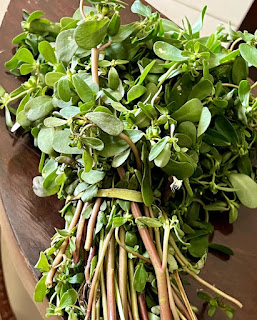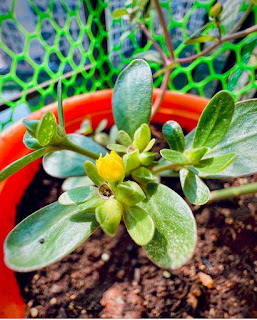Kulfa/ Luni Bhaji/ Nunia Saag / Purslane grows wild in India and it’s generally mistaken as weed…unlike spinach, fenugreek, mustard greens etc, this vegetable isn’t cultivated, few days back I saw this plant growing in my kitchen pots.. wild.. I was about to pluck, my house helper said let it grow… we can use in cooking.. this plant has immense health benefits. Staying in urban, most of us don’t know many of the greens that grows around wild… it’s off later that I have been noticing that sometimes some of the villagers come to the city from the nearby villages to sell these treasures.
This is an annual plant, the leaves and stems are succulent and the flowers can be of any colour like pink, white or yellow. The common one is yellow… The stem and the leaves are both edible, used in soups, salad or cooking. In India it’s cooked with dal, or with as sabji / bhaji. The taste of the leaves are bit tangy. Purslane has vitamins, minerals, and antioxidants that can be extremely beneficial to our health.
We can stir fry the greens with garlic and green chillies, or cook them with dal or make a gravy dish… one of the recipe that I make with this leafy vegetable is -
Ingredients
1 bunch of Kulfa leaves chopped
1 Potato cut into cubes
1 small Tomato chopped
1 tbsp chopped Garlic
2 Green Chillies cut into half
1 Dried Red Chilli
Salt to taste
1/2 tsp Turmeric powder
2 tbsp Oil
Method
Take a wok, add oil, once the oil heats up, reduce the flame, add the garlic and red dried chilli. Sauté the garlic, once the garlic turns light brown in colour, add the tomato, potato, salt and turmeric, stir and cook until the potato is half cooked. Add the chopped greens and green chillies. Stir and cover the wok. Let it cook until the water has evaporated and the vegetable and the potato has cooked completely. Serve this vegetable with rice or chapatis.









